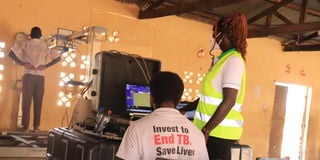Turkana posts improved results in fight against TB

Health workers screening residents for TB in Lokichar, Turkana South on March 15, 2024. Turkana County has recorded an improvement in the treatment of tuberculosis following intensified contact tracing of drug-resistant cases and screening.
What you need to know:
- Despite insecurity challenges, Turkana East Sub-county has recorded a high number of cured patients due to intensified screening and contact tracing.
- Health officials in the county identified villages neighbouring Uganda and South Sudan and the densely populated Kakuma Refugee Camp as high TB burden areas.
Turkana County has recorded an improvement in the treatment of tuberculosis following intensified screening and contact tracing of drug-resistant cases.
Latest reports from the county’s department of Health indicate that cure rate has improved from 43 per cent to 50 per cent and treatment success rate from 71 per cent to 83 per cent.
Despite insecurity challenges, Turkana East Sub-county has recorded a high number of cured patients due to intensified screening and contact tracing. Health officials in the county identified villages neighbouring Uganda and South Sudan and the densely populated Kakuma Refugee Camp as high TB burden areas.
County Director of Preventive and Promotive healthcare Bonventure Ameyo said many TB patients have been discontinuing treatment whenever they migrate to South Sudan or Uganda in search of water and pasture for their livestock.
“At the refugee camp, overcrowding has been a major challenge, with cases of reinfections reversing gains in the fight against the infectious disease,” Dr Ameyo said.
While echoing the need for more paediatric screening and testing of children below the age of two years, the official said there was a need to fast-track and improve on indicators to enhance performance outcomes.
County Chief Officer for Preventive and Promotive Peter Lomorukai called on development partners to replicate the success achieved in Turkana East Sub-county due to intensified screening and testing, even among children.
Mr Lomorukai urged the sub-county TB focal persons to identify interventions on the average monthly consumption of TB drugs.
County Tuberculosis and Lung Coordinator Job Okemwa urged key players to ensure accuracy in distributing the correct Drug-Resistant Tuberculosis (DR-TB) regimen per eligible patient.
“We seek to improve Drug-Resistant Tuberculosis surveillance for new and previously tested patients,” he said. The county officials shared action plans to clarify the timeliness, follow-ups and enable improvements on data reporting tools for increased case notification through strengthening healthcare facilities.
On the other hand, World Relief representative, Dennis Erot, requested the county team to offer their support on contact tracing to reduce the spread of TB cases.
To reduce TB infections along the border of Kenya and South Sudan, the Inter-Governmental Authority on Development (IGAD) TB/HIV programme was rolled out to strengthen community health systems that will be banked on to intensify contact tracing of patients and defaulters.
The programme under the Kenya Red Cross seeks to compliment member states’ efforts towards ending TB in Turkana West that covers the host and refugee communities as well as migratory population between Kenya and South Sudan.
Officials are focusing on the issue of paediatric TB and Multidrug-resistant TB because of an increasing number of tuberculosis patients discontinuing treatment.
Lost to follow-up (LTFU) patients failing to complete treatment were at risk developing drug resistance or can fuel a possible outbreak especially at congested settlements.
The situation is being made dire by alcoholism, lack of nutritional support and migration patterns both within the County and across the neighbouring international borders of Uganda, South Sudan and Ethiopia due to nomadic pastoralism lifestyle.
Kenya is on the list of the countries with a high TB burden globally and among the 30 countries that contribute to 80 per cent of the global TB burden.





